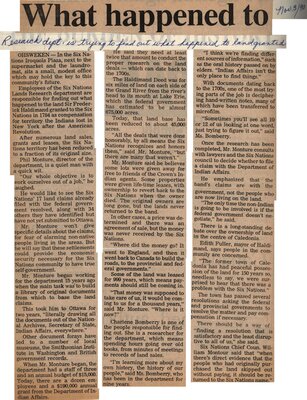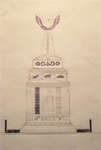"What Happened to Six Nations Land?"
- Full Text
- What happened to Six Nations land?
OHSWEKEN - In the Six Nations Iroquois Plaza, next to the supermarket and the laundromat, sits a small, modest office which may hold the key to this community's future.
Employees of the Six Nations Lands Research department are responsible for finding out what happened to the land Sir Frederick Haldimand granted to the Six Nations in 1784 as compensation for territory the Indians lost in New York after the American Revolution.
After numerous land sales, grants and leases, the Six Nations territory has been reduced to a fraction of its original size.
Phil Monture, director of the department, is a quiet man with a quick wit.
"Our whole objective is to work ourselves out of a job," he laughed.
He would like to see the Six Nations' 17 land claims already filed with the federal government resolved, along with 34 others they have identified but have not yet submitted to Ottawa.
Mr. Monture won't give specific details about the claims, for fear of alarming non-native people living in the areas. But he will say that these settlements could provide the economic security necessary for the Six Nations community to have true self-government.
Mr. Monture began working for the department 15 years ago when the main task was to build a library of original documents from which to base the land claims.
This took him to Ottawa for two years, "literally drawing all the documents out of the National Archives, Secretary of State, Indian Affairs, everywhere."
Other document forays have led to a number of local museums, the Smithsonian Institute in Washington and British government records.
When Mr. Monture began, the department had a staff of three and an annual budget of $15,000. Today, there are a dozen employees and a $190,000 annual grant from the Department of Indian Affairs.
He said they need at least twice that amount to conduct the proper research on the land deals - which can date back to the 1700s.
The Haldimand Deed was for six miles of land on each side of the Grand River from the river's head to its mouth at Lake Erie, which the federal government has estimated to be almost 675,000 acres.
Today, that land base has been reduced to about 45,000 acres.
"All the deals that were done honorably, by all means the Six Nations recognizes the honors them," said Mr. Monture, "but there are many that weren't."
Mr. Monture said he believes some lots were given way for free to friends of the Crown's Indian agents. Some properties were given life-time leases, with ownership to revert back to the Six Nations when the owner died. The original owners are long gone, but the lands never returned to the band.
In other cases, a price was determined and there was an agreement of sale, but the money was never received by the Six Nations.
"Where did the money go? It went to England, and then it went back to Canada to build the roads, to the provincial and federal governments."
Some of the land was leased for 999 years, which means payments should still be coming in.
"That money was supposed to take care of us, it would be coming to us for a thousand years," said Mr. Monture. "Where is it now?"
Charlene Bomberry is one of the people responsible for finding out. She is a researcher for the department, which means spending hours going over old books, from minutes of meetings to records of land sales.
"I'm learning more about my own history, the history of our people," said Ms. Bomberry, who has been in the department for nine years.
"I think we're finding different sources of information," such as the oral history passed on by elders. "Indian Affairs isn't the only place to find things."
With documents dating back to the 1700s, one of the most trying parts of the job is deciphering hand-written notes, many of which have been transferred to microfilm.
"Sometimes you'll see all 10 or 12 of us looking at one word, just trying to figure it out," said Ms. Bomberry.
Once the research has been completed, Mr. Monture consults with lawyers and the Six Nations council to decide whether to file a claim with the Department of Indian Affairs.
He emphasized that the band's claims are with the government, not the people who are now living on the land.
"The only time the non-Indian is going to be involved is if the federal government doesn't negotiate," he said.
There is a long-standing debate over the ownership of land in the centre of Caledonia.
Edith Fuller, mayor of Haldimand, says people in the community are concerned.
"The former town of Caledonia has had peaceful possession of the land for 150 years so, needless to say, we were surprised to hear that there was a problem with the Six Nations."
The town has passed several resolutions asking the federal and provincial governments to resolve the matter and pay compensation if necessary.
There should be a way of "finding a resolution that is satisfactory and the least disruptive to all of us," she said.
Six Nations Chief Coun. William Montour said that "when there's direct evidence that the people who had originally purchased the land skipped out without paying, it should be returned to the Six Nations name."
He wants the federal and provincial governments to help reimburse the parties who now hold title to the land. After that, he believes arrangements could be made to allow people to continue living on the property.
"We have the capability of building roads. Why can't these people, if they're not too concerned who they pay their taxes to, just pay them to us instead."
Few believe the land claims will be settled quickly, but the Six Nations officials are willing to stick with the government process until they have lost all hope of reaching a fair, negotiated settlement.
They say the courts are a last resort.
"Everyone wants our land base increased, and the only way that is going to happen is through negotiated settlements. Court decisions will only give you a financial settlement," said Mr. Monture.
With some financial compensation added to the money coming in from the leased lands, Mr. Monture sees a different future for his community.
"We would have our financial resources. We wouldn't need the (federal) government. We wouldn't have to ask anyone whether we can take down a rat-infested building, or take asbestos out of our schools.
"We'd be one of the most secure governments in the world - and we'd be an Indian government."
- Media Type
- Newspaper
- Item Types
- Articles
- Clippings
- Description
- "In the Six Nations Iroquois Plaza, next to the supermarket and the Laundromat, sits a small, modest office which may hold the key to this community's future."
- Date of Original
- Fall 1990
- Subject(s)
- Personal Name(s)
- Haldimand, Frederick ; Monture, Phil ; Bomberry, Charlene ; Fuller, Edith ; Montour, William.
- Corporate Name(s)
- Six Nations Land Research Department ; Six Nations Iroquois Plaza ; Department of Indian Affairs.
- Local identifier
- SNPL002779v00d
- Collection
- Scrapbook #2
- Language of Item
- English
- Geographic Coverage
-
-
Ontario, Canada
Latitude: 43.06681 Longitude: -80.11635
-
- Creative Commons licence
 [more details]
[more details]- Copyright Statement
- Public domain: Copyright has expired according to Canadian law. No restrictions on use.
- Copyright Date
- 1990
- Contact
- Six Nations Public LibraryEmail:info@snpl.ca
Website:
Agency street/mail address:1679 Chiefswood Rd
PO Box 149
Ohsweken, ON N0A 1M0
519-445-2954




